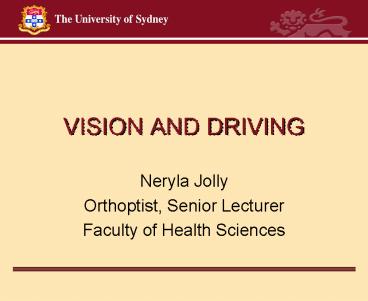VISION AND DRIVING - PowerPoint PPT Presentation
1 / 30
Title:
VISION AND DRIVING
Description:
Driver Team Orthoptist, OT, Driving Instructor. Experience: ... 6 (SD1) 0-4. Blind spot right. Road position change .4 (SD.76) 0-4. dashboard. regularly ... – PowerPoint PPT presentation
Number of Views:96
Avg rating:3.0/5.0
Title: VISION AND DRIVING
1
VISION AND DRIVING
- Neryla Jolly
- Orthoptist, Senior Lecturer
- Faculty of Health Sciences
2
Driver Team Orthoptist, OT, Driving Instructor
- Experience
- Drivers with disability visual and physical
- Off and on-road assessment
- Remediation
- Research
- OHS assessments
- Consultancies
- Community senior sessions
3
Aim of talk
- Expertise in vision and driving to include
- Understanding of eye conditions
- Vision tests
- Impact on driving skill / living
- Practical tips
4
Requirements for driving
- Knowledge of the rules of the road
- Skills to handle a vehicle
- Good vision -3 criteria
- The right attitude
- The ability to manage all this in a moving
rapidly changing environment
5
Vision requirement ONE
- Acuity of 6/12 (no 5)
- Num 8 6/6 is normal
- Num 9 6/5 is frequent
6
- Why might vision be
- less than this level?
- Need glasses
- Cataracts
- Macular problems
- Eye diseases
- Can the acuity be improved?
7
Acuity defects what happens in driving?
- Vehicle control- very good / expert
- Sign identification
- Road position
- Speed
- Scan
- Mirror use
- Hazard identification
8
Acuity defects what happens in driving?
- Sign identification- 1 line decrease worse than
6/12 sign identification 1 car length away, 2
lines decrease worse signs often missed - Road position all decreased vision levels
variable to right and left, often over the middle
line, 2 lines decrease and worse near
collisions (use passenger)
9
Acuity defects what happens in driving?
- 3. Speed slow
- 4. Scan often fixed, trained but non effective
10
Acuity defects what happens in driving?
- 5. Mirror use routine
- 6. Hazard identification all decreased vision
levels, missed trucks pedestrians
11
Vision requirement TWO
- No double vision in the central area
12
(No Transcript)
13
- Why might double vision appear?
- 1. Head injury 2. Neurological conditions
- 3 Medical conditions (diabetes, )
- Can the double vision be improved?
14
Double vision what happens in driving?
- Shock (woman / stroller)
- Confusion about signs / road markings
- Scanning avoided
- Missing hazards cars on roundabouts,
pedestrians - Distance judgment problems
- Extensive head postures
15
Vision requirement THREE
- Peripheral vision 120 degrees
16
Binocular peripheral vision numeric field
results static
kinetic
17
(No Transcript)
18
(No Transcript)
19
- What might cause peripheral vision to decrease?
- Glaucoma
- Neurological conditions
- Retinal problems
- Can the peripheral vision be improved?
20
- What effect does peripheral vision loss have on
driving? - Reduced field poor driving performance
- Make errors of identification of objects opposite
side of loss - Position judgment poor in confined spaces
- Some drivers compensate by scanning
21
Changing age and driving
- What we do know
- Visual sensitivity decreases (response to glare
and in reduced light stereopsis) - After the age of 70 years the accident rate
increases - Driving is extremely important for independence,
safety and life enjoyment - Experience is important in driving
22
Contrast sensitivity (light dark) visual
sensitivity age.
23
Senior Drivers Study
- 100 drivers aged 60 to 85 years
- 65 males, 35 females
- drive between 1 to 6 hours a day (41 1hour, 23
2 hours) 95 stated they were comfortable when
driving. - 86 drive between 1 6 nights a week (26 1
night 34 2 nights a week) 74 are comfortable
driving at night
24
Vision responses
- Visual acuity both eyes- 6/5 mean (9)
- (range 6/60 (1) to 6/3 (11) )
- Peripheral vision 49 with no errors 24 with
lt 7 errors 9 with gt20 errors - Double vision- 2
- Stereopsis
- 25 full response
- 15 no response
25
Senior Drivers Study- results from 33 question
pairs
- Driving into setting sun (Light related
situation) - Road markings wet road, night (Light related
situation) - High pedestrian area
- Right turn without lights (Vehicle Direction
change) - Left lane change (Vehicle Direction change)
- Dark with dim street lights (Light related
situation) - Right turn at roundabout (Vehicle Direction
change) - Traffic lights at dusk (Light related situation)
- high accident
26
Senior Drivers Study, Results Vision Behaviours
27
Senior Drivers, results - commentary
- GENERAL AREA ITEM (n 14) PERFORMED
- SIGN Lidcombe 57
- Children 41
- School zone 70
- Zigzag crossing on road 22
- Pedestrian crossing 42 32
- Hump 47 twice
- SPEED 40 kmh 80
- 25kmh 82 77
- 50 kmh 79, 62 57
- PEDESTRIAN CROSSING 28 22
28
Senior Drivers what have we learnt
- Senior Drivers identify problems in light related
situations, vehicle direction change and high
pedestrian numbers require more care - 2. Speed signs and school signs cause more
conscious reporting - 3. Some skills could be improved to increase safe
driving potential - Blind spot checks
- Dash board checks
- Rear view mirror checks
29
ENVIRONMENT SUPPORT
- Road signs clearly positioned
- Road signs clean
- Road markings clear (changed markings removed)
- Shoulder of road smooth junction surface
- Clearly defined gutters
30
- For more information
- Neryla Jolly
- Driver Vision Specialist
- The University of Sydney
- N.Jolly_at_usyd.edu.au































